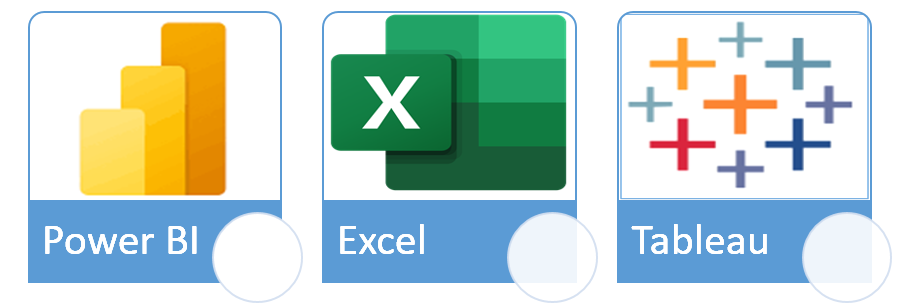Power BI, Excel and Tableau are data analysis and visualization tools. All three tools are powerful and provides many functionalities. Each of them have some functional similarities but have different strengths.

Power BI vs Excel vs Tableau
Comparison of Power BI, Excel and Tableau can be done based on different features:
- Ease of Use
- Data Connectivity
- Data Manipulation and Modeling
- Visualization Capabilities
- Collaboration and Sharing
- Pricing
- Use Cases
Lets discuss each feature comparison in detail:
Ease of Use
- Excel is one of the first data analysis tools. It is part of Microsoft office and is very familiar in work environments.
- User Interface – Its features are already known by many users therefore making it easy to manipulate data and create basic visualizations.
- Learning Curve – For new users learning curve is low to moderate.
- Power BI has a modern interface compared to excel that emphasizes on user experience.
- User Interface – Power BI is easier to use for user who has knowledge about Excel. Power BI provides drag & drop features that make creating visualizations very simple.
- Learning Curve – For new users learning curve is moderate.
- Tableau
- User Interface – Tableau is characterized by sophisticated data visualization skills. Despite being easy to use especially when creating complex visuals, it is also harder for the new users as opposed to excel and Power BI.
- Learning Curve – For new users learning curve is steeper compared to Power BI and Excel.
Data Connectivity
- Excel
- Data Sources – Excel has the capability to connect with a variety of data sources (like CSVs, Databases or Web data) but not as many as Power BI or Tableau.
- Data Capacity – Excel has limitations with system memory and some internal constraints, because of which it becomes challenging and time consuming to work with large data sets.
- Real-Time Data – Excel has limited capability to handle real-time data.
- Power BI
- Data Sources – Power BI on the other hand connects with many different types of sources both online and offline resources including big data platforms, cloud services, and SQL databases.
- Data Capacity – Power BI has the capability to handle large data sets. Performance can take hit with complex queries.
- Real-Time Data – Power BI supports integration with real-time data. Power BI is best known for performing data modification and modelling using Power Query.
- Tableau
- Data Sources – Tableau also supports multiple data-sources including CSVs, SQL Server or MySQL among others.
- Data Capacity – Tableau is able to handle large datasets efficiently with in-memory processing and optimized performance. Having such functions as data blending makes it possible for multiple dashboards to pull their information from different places at once.
- Real-Time Data – Tableau supports real-time data connectivity and processing.
Data Manipulation and Modeling
- Excel
- Data Analysis – Excel has powerful data manipulation capabilities, with tools like pivot tables and advanced formulas. But managing and analysis with big data set is little complex.
- Power BI
- Data Analysis – Power BI uses its own language DAX (Data Analysis Expression) for data analysis. Power BI us easily capable of heavy-weight data modeling. Power BI also supports advanced calculations and aggregations.
- Tableau
- Data Analysis – Tableau also provides data analysis and data manipulation tools but is not as powerful as DAX of Power BI. Tableau is more focused towards data visualization.
Visualization Capabilities
- Excel
- Data Visualization – Excel offers basic charts and graphs but they are not as pleasing and dynamic in any way when compared to either Power BI or Tableau.
- Power BI
- Data Visualization – Power BI offers a wider variety of visualization options. It also provides sell and purchase of visualizations options from the marketplace. Power BI becomes more interactive because of these multiple visualization options.
- Tableau
- Data Visualization – Tableau is known for superior and varied visualization capabilities. It allows users to create attractive-looking dashboards that are rich in content and with complete details. Tableau becomes more interactive because of these visualization capabilities.
Collaboration and Sharing
- Excel – Files sharing with Excel is easy. Mostly excel has offline sharing capability. Excel lacks in collaboration features. It does not allow multiple users to simultaneously access and working capability.
- Power BI – Power BI offers great collaboration features through its Power BI Service which enables dashboards to be shared within the cloud and in real time.
- Tableau – Tableau Server together with its online version has the capability to share and collaborate. It makes dashboards accessible to different stakeholders.
Pricing
- Excel – It’s often included as part of Microsoft’s Office Suite, thus making it an affordable choice for lots of users.
- Power BI – It has free desktop version (Power BI Desktop), whereas its Pro version along with Premium options have prices that compare favorably with those charged by other BI tools.
- Tableau – Generally regarded as more costly than others with licensing fees. It cost limits its affordability with small businesses or individual users.
Use Cases
- Excel – Excel is ideal for smaller datasets, can provide quick analyses, and reporting. It is mostly used in finance, accounting, and operations.
- Power BI – Power BI suited for business intelligence projects, dashboard creation, and organizational reporting, particularly in environments that leverage Microsoft tools.
- Tableau – Tableau is preferred in scenarios requiring in-depth data visualization, analytics, and storytelling with data, often used in marketing, research, and data science.
Summary
In this article, we did the comparison of Power BI, Excel and Tableau based on their different features, capabilities and use cases.
